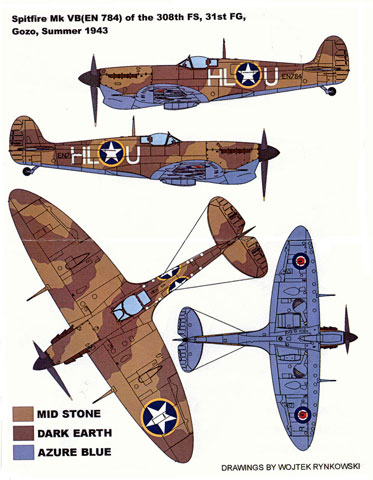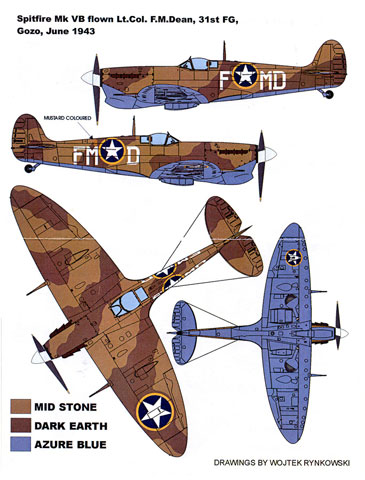|
S u m m a r y |
| Catalogue
No., Description and Price |
K48002 - American Spitfire
VB Trop Marking Masks
Available online from Karaya |
| Contents and
Media: |
Black flexible,
self-adhesive vinyl masks for canopies, wheels, national
markings, codes and serials |
| Scale: |
1/48 (also available in other
scales) |
| Review
Type: |
FirstLook |
| Advantages: |
Precise matching to
reference;
strong adhesive; no seepage or
leakage under masks; well thought-out design; different
thickness masks for different functions. |
| Disadvantages: |
Extra time and effort
required |
| Recommendation: |
Recommended |
Reviewed by Rodger Kelly

HyperScale is proudly supported by
Squadron.com
Here is something
different!
Plastic Model Club
Montex is a new company out of Poland. They produce a bewildering
and ever expanding array of masking products including Maxi Mask,
Mini Mask and now, Super Mask.
 So,
what are Super Masks and how do you use them? Well quite simply, it
is a system of die-cut vinyl masks that you use in a "negative
image" method. For example, to reproduce a black serial number on
the side of the fuselage you first spray the area where the serial
is black. You then apply the individual letter and numeral masks.
Once the masks are applied, you spray the airframe in the camouflage
scheme the aircraft wore. When the paint is touch dry, you then
remove the masks to reveal the black painted serial. So,
what are Super Masks and how do you use them? Well quite simply, it
is a system of die-cut vinyl masks that you use in a "negative
image" method. For example, to reproduce a black serial number on
the side of the fuselage you first spray the area where the serial
is black. You then apply the individual letter and numeral masks.
Once the masks are applied, you spray the airframe in the camouflage
scheme the aircraft wore. When the paint is touch dry, you then
remove the masks to reveal the black painted serial.
Simple? Yes in
theory but in practice you will have to contend with compound curves
and ensuring that the mask is burnished down over surface detail to
ensure that the camouflage scheme paint does not bleed under the
mask.
Advantages? The
final effect will truly be the "painted on markings effect" that we
all want, there is no decal film surrounding the markings, and no
chance of "silvering".
Disadvantages? You
will have to mix the paint for the national markings yourself or buy
them off the shelf. The extra steps involved and hence the
increased time that you will spend on each model – whilst this is
not a problem for some it is a definite disadvantage if you are
trying to get through your stash! Another disadvantage is that
there is no room for error. If you fail to place the mask
correctly, your marking will be "out of register".
Well, having
expounded on the method, advantages and disadvantages of this
method, what does the set provide?
Super Mask K 48002
provides masks for the national insignia and squadron markings for
two reverse lend-lease Mk VB spitfires of the USAAF's 31st Fighter
Group USAAF.
EN784 of the 308th
Fighter Squadron, 31st Fighter Group. The markings depict it when
it was based at Gozo, (a small island situated
about two miles off Malta and about eighty miles from Sicily) in
1943 The machine is finished in dark earth and middle stone
upper surfaces with azure blue undersides and a black spinner.
Masks are provided for:
EN784 serial (you
get four of these).
HL squadron and
individual aircraft U code letters.
 The
other option is aircraft flown by the 31st Fighter Group's
Commanding Officer, Lieutenant Colonel F (Frank) M Dean and no
serial is given. This option is also finished in mid stone, dark
earth and azure blue and it sports a white spinner. Masks are
provided for: The
other option is aircraft flown by the 31st Fighter Group's
Commanding Officer, Lieutenant Colonel F (Frank) M Dean and no
serial is given. This option is also finished in mid stone, dark
earth and azure blue and it sports a white spinner. Masks are
provided for:
FM and D codes –
these are the CO's initials as it was his privilege to have his
aircraft painted in this manner.
A single set of US
yellow ringed national insignias for the fuselage and upper port
wing and RAF type D roundels (for the under sides of both wings on
the first option) are also provided to share between both machines.
An errata sheet is provided and it holds a set of HL and U codes as
well as two sets of RAF type D roundels. This last one was a tad
puzzling as I didn't have an "incorrect" sheet in my sample.
There are also two sets of canopy masks included in the set. One
set is specifically for a Mk 1 whilst the other is for a Mk V.
These are very complete and include a mask for the
navigation/identity light in the belly of the Mk V. Curiously,
there is only one set for the transparency on the spine behind the
sliding hood.
The masks
themselves look to be of the same material that Eduard uses in their
mask sets (the older green ones, not the newer tan ones) whilst the
canopy masks are black.
The placement guide
is a small double sided affair that shows four-view colour plans for
each machine. The rear of the header card carries a "parts layout"
to help you in identifying each mask.
Packaging is the
ubiquitous clear plastic zip-loc bag into which the masks, placement
guide and header sheet are placed. A piece of stiff cardboard is
also included to save you masks from being bent and creased.
The recommended kit
is the Tamiya one.
Recommended for
anyone with plenty of time and patience.
Footnote
I have found
that it helps to use warm soapy water to assist in placing vinyl
masks of this type. Simply paint the area where the mask is to be
affixed first with the water and place the mask, and then adjust the
mask to where you want it to sit. The water seems to take the edge
off the "stickiness" of the mask and lets you slide it around. Once
it is where you want it to be simply burnish the mask down by
rolling it from the centre outwards. This both removes the water
and burnishes the mask to prevent from bleeding underneath.
Thanks to Dariusz Korczynski from Plastic Model
Club for the review sample
Maxi Mask is available
online from Karaya
Model, Text and Images Copyright © 2005 by Rodger
Kelly
Page Created 06 February, 2005
Last updated
06 February, 2005
Back to HyperScale Main
Page
Back to Reviews
Page |
Home | What's
New | Features
| Gallery |
Reviews | Reference
| Forum
| Search